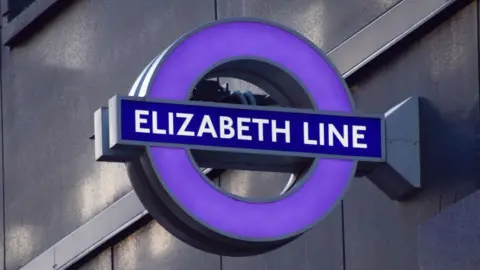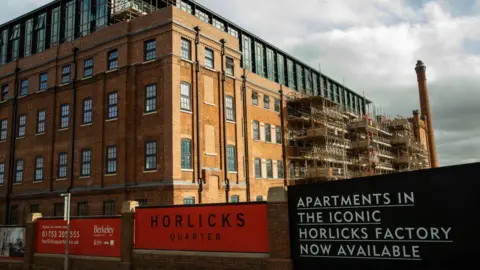Harry CraigLondon
 Getty Images
Getty ImagesLike many in their mid-20s, Tia Costell feels young people are being priced out of finding their own place to live.
“It’s hard enough for people to rent in London, let alone get on the property ladder. Properties are so expensive and hard to come by – if you can’t get there on the same day, you can’t even get a viewing.”
This is a familiar story across the country, and particularly in London.
But has the capital’s flagship infrastructure project – the Elizabeth line – made renting even more expensive?
The Elizabeth line opened in May 2022, and has become the UK’s busiest railway line, carrying one in six train journeys in the whole country, according to Transport for London (TfL).
Figures from the Office for National Statistics suggest there has been a disproportionate rise in rents along its route.
Between June 2022 and June 2025, the average rent in areas near Elizabeth line stations rose by about 28%.
This was about the same as the London average, but higher than in the wider south east (up by 22%) and the rest of the UK (up by 24.5%).
Matt Hutchinson, communications director at SpareRoom, argued that “rents have risen disproportionately everywhere”, meaning “there’s really nowhere affordable”.
However, he pointed out that “good, quick transport links”, such as the Elizabeth line, had put prices up even more in certain places.
‘The best thing to come to London’
 Matt Reading / MCR Photography
Matt Reading / MCR PhotographyThis is most noticeable in peripheral areas such as Ealing, which is served by five Elizabeth line stations and where rents have risen by about 30%.
In July, Ealing Council attributed rent increases in its borough – the highest in London – to “Ealing-specific factors” such as the Elizabeth line.
Southall station in Ealing saw the highest rise in rents along the line in London, up 53% for a two-bedroom property from £1,288 in 2022 to £1,970 in 2025.
Tia, 25, recently moved into a property in Ealing, which she could only afford due to the London Living Rent scheme.
She said she could understand the appeal of living near the Elizabeth line for locals and commuters alike.
“It’s amazing for access to everywhere, Ealing is so well connected,” she said.
“I can get into central London in 15 minutes, and I’m able to quickly get to the other side of London – the Elizabeth line is the best thing to come to London in that sense.”
 Getty Images
Getty ImagesRob Anderson, research director for the think tank Centre for London, said that the Elizabeth line had “changed where the boundaries of the city are” by unlocking areas that were previously poorly served by transport links.
Consequently, rises are disproportionately high west of London, where the line enters Berkshire, he said.
This includes Slough, where rents are up by almost a third, from £1,167 in June 2022 to £1,529 in June 2025.
Kevin Sims, director of shared ownership company SO Resi, said the Elizabeth line had made the Berkshire town considerably more desirable.
“Slough is big, and it’s getting bigger. We had 56 properties advertised on the London Living Rent scheme in Slough, and had 1,300 inquiries,” he said.
Mr Sims argued that the Elizabeth line had opened up Slough to a “new type of renter”, with more families and middle-aged couples.
Rent rises have been much lower at the eastern end of the Elizabeth line.
Brentwood in Essex saw the smallest increase along the line’s route, where rents rose by about 15% between June 2022 and June 2025.
Brentwood landlord Rob Pritchard, who contacted the BBC via Your Voice, Your BBC News, said he felt that the Elizabeth line had made the town more appealing for commuters – but that was not a new phenomenon.
“Brentwood has always had the knock-on effect from London,” he said.
However, the Elizabeth line is not the only factor at play in higher rent rises in peripheral parts of London.
Flexible working arrangements during the Covid-19 pandemic mean that working from home has been a regular part of working patterns, allowing people to live further from their place of work.
A report from TfL and the Department for Transport last year said the “increased attractiveness” of peripheral Elizabeth line stations, both due to improved connectivity and new hybrid working patterns since the pandemic, made suburban areas “more attractive”, leading to “demand and price growth around these places”.
“The difficulty we have in assessing the true impact of the Elizabeth line is that it came on board in 2022, just as working patterns were also changing,” Scott Cabot, head of residential research at real estate consultancy CBRE, said.
Disclaimer : This story is auto aggregated by a computer programme and has not been created or edited by DOWNTHENEWS. Publisher: BBC









